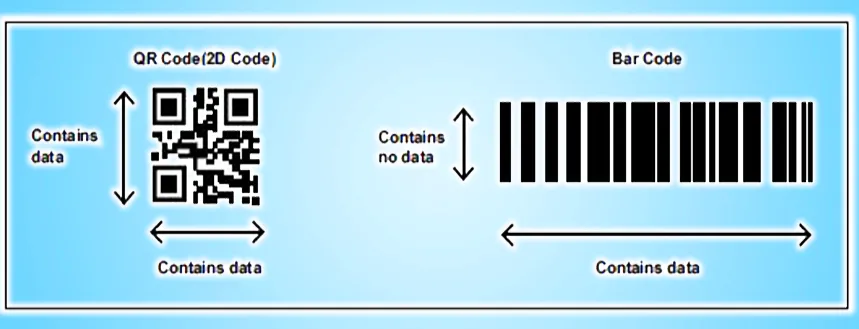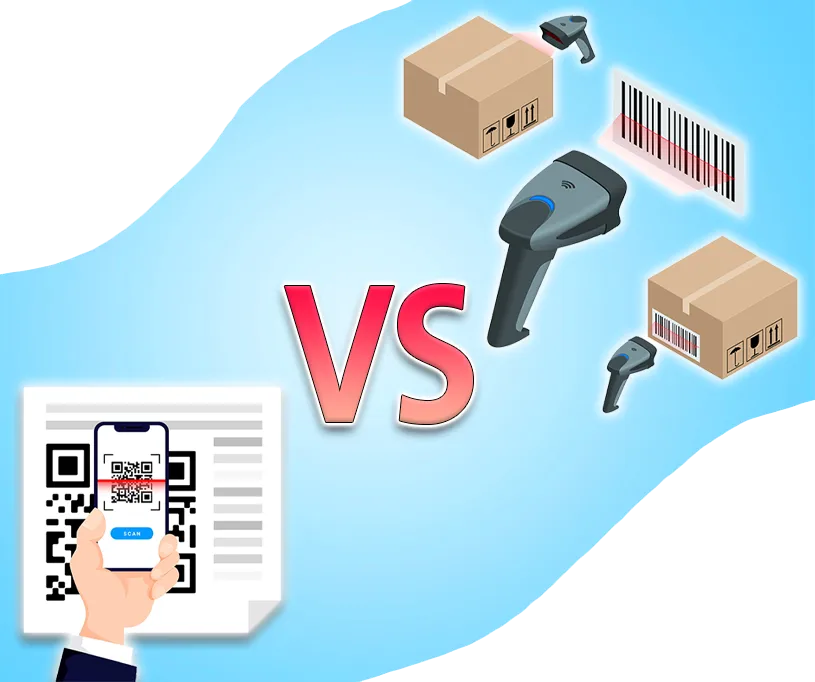Introduction:
In the world of technology and retail, barcodes and QR codes are essential tools for managing and tracking products. They help in storing and accessing information efficiently. Although they serve similar functions, they have distinct characteristics and uses. This blog will explore what barcodes and QR codes are, their differences, and how they benefit businesses and consumers alike.
1- What is a Barcode ?
A barcode is a universal encoding system used to identify products quickly and efficiently.
It consists of a series of parallel lines of varying widths and spacings that encode data readable by machines.
Originally designed to speed up inventory and checkout processes, barcodes have evolved significantly since their inception.

1.1- History of Barcodes
The concept of barcoding dates back to the early 1950s, but it wasn’t until the 1970s that it gained widespread adoption. The technology was first employed by large retail chains like Walmart to enhance inventory management and streamline sales operations. Over time, barcodes became a standard in various industries, including healthcare, manufacturing, and logistics.
1.2- The Inventors of the Barcode
Barcodes were invented by American engineers Norman Woodland and Bernard Silver in 1952. Their goal was to develop a technology that would automate inventory management and enhance operational efficiency. The Barcode system they created laid the groundwork for the barcode technology used today.
In 1973, GS1, a global organization, was established to develop and maintain barcode standards. GS1’s work includes issuing unique barcode identifiers and specifying the standards and systems necessary for effective barcode use.

1.3- How Barcodes are Created and Issued
Barcodes are assigned to products based on standards set by GS1 or other similar organizations.
Companies must register with these organizations to obtain unique barcode identifiers for their products.
These identifiers allow for efficient tracking, inventory management, and sales operations.

1.4- Types of Barcodes
- UPC Barcode: Consists of 12 digits and is widely used in the United States for retail products.
- EAN Barcode: Also known as European Article Number, it can be 12 or 13 digits long and is commonly used worldwide.
- ISBN Barcode: Used for books, consisting of 13 digits.
The 13-digit barcode is the most prevalent in international trade, adhering to global standards set by GS1.
1.5- How to Read a Barcode
A barcode comprises a series of lines and spaces arranged in a specific pattern, along with numbers underneath. The first three digits represent the country of origin, the following numbers identify the manufacturer, and the final digits specify the product itself.

2-What is a QR Code ?
A QR (Quick Response) code is a type of two-dimensional barcode, often considered an advanced or “second-generation” barcode. Unlike traditional barcodes, QR codes use a matrix of small squares to encode data, allowing them to store much more information.
2.1- The Invention of QR Codes
QR codes were developed by the Japanese company Denso Wave in 1994. They were designed to address the limitations of traditional barcodes by storing larger amounts of data and offering faster scanning. The technology was initially used in automotive manufacturing but quickly spread to various other sectors.

2.2- Why QR Codes Were Invented
Traditional barcodes were limited to encoding basic product information, such as product type and country of origin. QR codes were developed to store a more extensive range of information quickly and efficiently. They can represent URLs, text, contact details, and more, making them versatile for various applications.

2.3- Advantages and Benefits of QR Codes
- Large Data Capacity: QR codes can store extensive data, including long URLs, detailed text, and complex information.
- Quick and Easy Scanning: They can be scanned quickly using smartphones or dedicated scanners, making them user-friendly.
- Customizable: QR codes can be easily generated using online tools, allowing for custom designs and branding.
- Durability: QR codes are resilient to damage and can be read accurately even if partially obscured or damaged.
- Versatility: They support diverse applications, including directing users to websites, providing contact details, and storing product information.
- Wide Usage: QR codes are utilized in marketing, electronic payments, healthcare, logistics, and many other fields.
- Printable on Various Surfaces: QR codes can be printed on numerous materials, from advertisements and business cards to packaging and clothing.
3- Key Differences Between Barcodes and QR Codes :

- Data Capacity:
- Barcodes: Typically store up to 20-30 characters.
- QR Codes: Can store up to 4,000 characters, making them suitable for more complex data.
- Design and Structure:
- Barcodes: Comprise parallel lines and spaces.
- QR Codes: Use a matrix of squares or dots arranged in a grid pattern.
- Scanning Requirements:
- Barcodes: Generally require a dedicated scanner or reader.
- QR Codes: Can be scanned using smartphones with built-in cameras and QR code scanning apps.
- Error Correction:
- Barcodes: Limited error correction capabilities.
- QR Codes: Include error correction, allowing them to be read even if partially damaged.
- Application Scope:
- Barcodes: Primarily used in retail, inventory management, and logistics.
- QR Codes: Used in a broader range of applications, including marketing, payments, and digital content.


3.2- Real-World Applications
Barcodes :
- Retail: Speed up checkout processes and inventory management.
- Healthcare: Track medication and patient information.
- Manufacturing: Manage production lines and quality control.
QR Codes :
- Marketing: Direct customers to websites, promotions, and social media.
- Payments: Facilitate secure transactions and mobile payments.
- Healthcare: Store patient information and medical records.
- Logistics: Track shipments and manage supply chains.

Conclusion
Both barcodes and QR codes are integral to modern business operations, each serving unique purposes and offering specific advantages. Barcodes remain essential for straightforward product identification and inventory management, while QR codes provide a more versatile and data-rich solution for various applications. Understanding these technologies helps businesses and consumers make informed choices, improve efficiency, and enhance the overall shopping experience.






